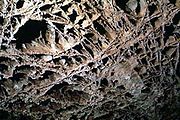
Boxwork
Encyclopedia

Speleogen
A Speleogen is a geological formation within a cave that has been created by the removal of bedrock, rather than as a secondary deposit. They are typically formed in limestone or dolostone solutional caves...
(similar to a speleothem
Speleothem
A speleothem , commonly known as a cave formation, is a secondary mineral deposit formed in a cave. Speleothems are typically formed in limestone or dolostone solutional caves.-Origin and composition:...
, but formed by erosion rather than accretion), occasionally found in cave
Cave
A cave or cavern is a natural underground space large enough for a human to enter. The term applies to natural cavities some part of which is in total darkness. The word cave also includes smaller spaces like rock shelters, sea caves, and grottos.Speleology is the science of exploration and study...
s and erosive environments.
Boxwork is commonly composed of thin blades of the mineral calcite
Calcite
Calcite is a carbonate mineral and the most stable polymorph of calcium carbonate . The other polymorphs are the minerals aragonite and vaterite. Aragonite will change to calcite at 380-470°C, and vaterite is even less stable.-Properties:...
that project from cave walls or ceilings that intersect one another at various angles, forming a box-like or honeycomb
Honeycomb
A honeycomb is a mass of hexagonal waxcells built by honey bees in their nests to contain their larvae and stores of honey and pollen.Beekeepers may remove the entire honeycomb to harvest honey...
pattern. The boxwork fins once filled cracks in the rock before the host cave formed. As the walls of the cave began to dissolve away, the more resistant vein and crack fillings did not, or at least dissolved at a slower rate than the surrounding rock, leaving the calcite fins projecting from the cave surfaces.
Some of the most extensive boxwork deposits in the worlds are found in Wind Cave, Wind Cave National Park
Wind Cave National Park
Wind Cave National Park is a United States national park north of the town of Hot Springs in western South Dakota. Established in 1903 by President Theodore Roosevelt, it was the seventh U.S. National Park and the first cave to be designated a national park anywhere in the world. The cave is...
in South Dakota
South Dakota
South Dakota is a state located in the Midwestern region of the United States. It is named after the Lakota and Dakota Sioux American Indian tribes. Once a part of Dakota Territory, South Dakota became a state on November 2, 1889. The state has an area of and an estimated population of just over...
, USA. Other outstanding examples occur in Cody Caves
Cody Caves
The Cody Caves are a network of limestone caves in the Selkirk Mountains in British Columbia, Canada. They are located north of Ainsworth Hot Springs on the west side of Kootenay Lake....
, Cody Caves Provincial Park
Cody Caves Provincial Park
Cody Caves Provincial Park is a provincial park in British Columbia, Canada. It was formed in July 1966 to protect the Cody Caves and was the first subterranean park in British Columbia. The park is 13 km by road, northwest from the hot springs community of Ainsworth on Kootenay Lake.-External...
in British Columbia
British Columbia
British Columbia is the westernmost of Canada's provinces and is known for its natural beauty, as reflected in its Latin motto, Splendor sine occasu . Its name was chosen by Queen Victoria in 1858...
, Canada.

